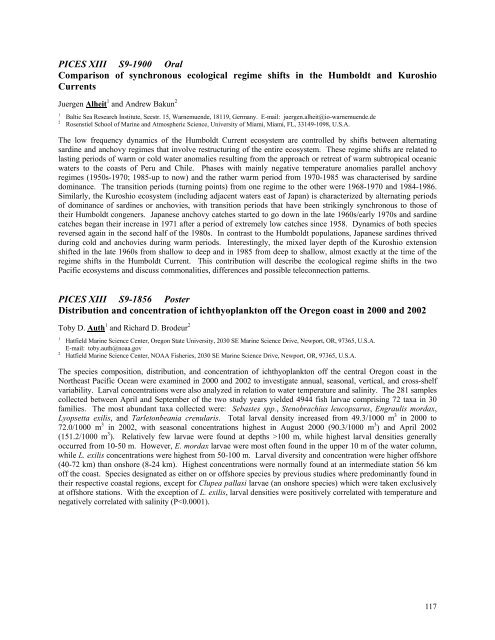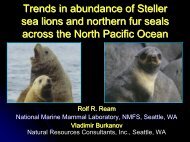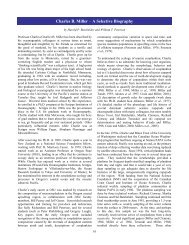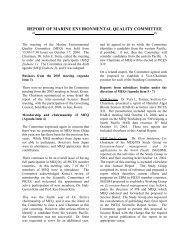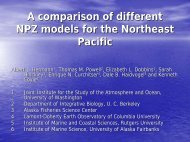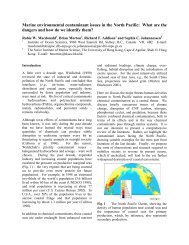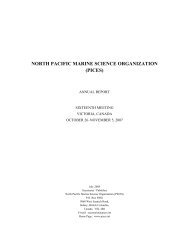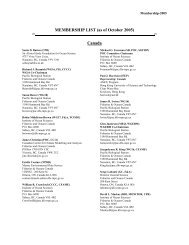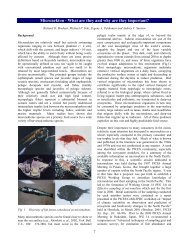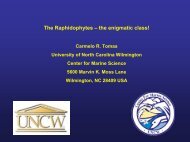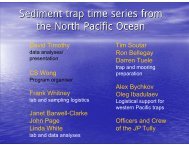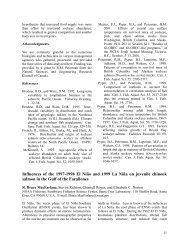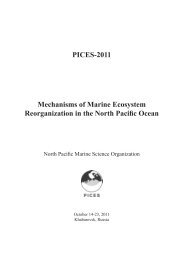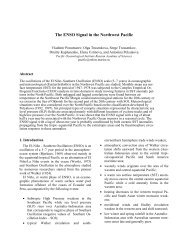Full Book - PICES
Full Book - PICES
Full Book - PICES
- No tags were found...
You also want an ePaper? Increase the reach of your titles
YUMPU automatically turns print PDFs into web optimized ePapers that Google loves.
<strong>PICES</strong> XIII S9-1900 OralComparison of synchronous ecological regime shifts in the Humboldt and KuroshioCurrentsJuergen Alheit 1 and Andrew Bakun 212Baltic Sea Research Institute, Seestr. 15, Warnemuende, 18119, Germany. E-mail: juergen.alheit@io-warnemuende.deRosenstiel School of Marine and Atmospheric Science, University of Miami, Miami, FL, 33149-1098, U.S.A.The low frequency dynamics of the Humboldt Current ecosystem are controlled by shifts between alternatingsardine and anchovy regimes that involve restructuring of the entire ecosystem. These regime shifts are related tolasting periods of warm or cold water anomalies resulting from the approach or retreat of warm subtropical oceanicwaters to the coasts of Peru and Chile. Phases with mainly negative temperature anomalies parallel anchovyregimes (1950s-1970; 1985-up to now) and the rather warm period from 1970-1985 was characterised by sardinedominance. The transition periods (turning points) from one regime to the other were 1968-1970 and 1984-1986.Similarly, the Kuroshio ecosystem (including adjacent waters east of Japan) is characterized by alternating periodsof dominance of sardines or anchovies, with transition periods that have been strikingly synchronous to those oftheir Humboldt congeners. Japanese anchovy catches started to go down in the late 1960s/early 1970s and sardinecatches began their increase in 1971 after a period of extremely low catches since 1958. Dynamics of both speciesreversed again in the second half of the 1980s. In contrast to the Humboldt populations, Japanese sardines thrivedduring cold and anchovies during warm periods. Interestingly, the mixed layer depth of the Kuroshio extensionshifted in the late 1960s from shallow to deep and in 1985 from deep to shallow, almost exactly at the time of theregime shifts in the Humboldt Current. This contribution will describe the ecological regime shifts in the twoPacific ecosystems and discuss commonalities, differences and possible teleconnection patterns.<strong>PICES</strong> XIII S9-1856 PosterDistribution and concentration of ichthyoplankton off the Oregon coast in 2000 and 2002Toby D. Auth 1 and Richard D. Brodeur 212Hatfield Marine Science Center, Oregon State University, 2030 SE Marine Science Drive, Newport, OR, 97365, U.S.A.E-mail: toby.auth@noaa.govHatfield Marine Science Center, NOAA Fisheries, 2030 SE Marine Science Drive, Newport, OR, 97365, U.S.A.The species composition, distribution, and concentration of ichthyoplankton off the central Oregon coast in theNortheast Pacific Ocean were examined in 2000 and 2002 to investigate annual, seasonal, vertical, and cross-shelfvariability. Larval concentrations were also analyzed in relation to water temperature and salinity. The 281 samplescollected between April and September of the two study years yielded 4944 fish larvae comprising 72 taxa in 30families. The most abundant taxa collected were: Sebastes spp., Stenobrachius leucopsarus, Engraulis mordax,Lyopsetta exilis, and Tarletonbeania crenularis. Total larval density increased from 49.3/1000 m 3 in 2000 to72.0/1000 m 3 in 2002, with seasonal concentrations highest in August 2000 (90.3/1000 m 3 ) and April 2002(151.2/1000 m 3 ). Relatively few larvae were found at depths >100 m, while highest larval densities generallyoccurred from 10-50 m. However, E. mordax larvae were most often found in the upper 10 m of the water column,while L. exilis concentrations were highest from 50-100 m. Larval diversity and concentration were higher offshore(40-72 km) than onshore (8-24 km). Highest concentrations were normally found at an intermediate station 56 kmoff the coast. Species designated as either on or offshore species by previous studies where predominantly found intheir respective coastal regions, except for Clupea pallasi larvae (an onshore species) which were taken exclusivelyat offshore stations. With the exception of L. exilis, larval densities were positively correlated with temperature andnegatively correlated with salinity (P


